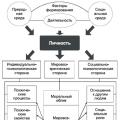Table of class structure in the 17th century. Political development in the 17th century
Estates in the 17th century.
Boyars and nobles. Among all classes and estates, the dominant place undoubtedly belonged to the feudal lords. In their interests, the state government took measures to strengthen the ownership of the boyars and nobles to land and peasants, to unite the strata of the feudal class, to “noble” it. Service people in the country took shape in the 17th century. into a complex and clear hierarchy of ranks obliged to the state for service in the military, civil, and court departments in exchange for the right to own land and peasants. They were divided into the ranks of Duma (boyars, okolnichy, Duma nobles and Duma clerks), Moscow (stewards, solicitors, Moscow nobles and tenants) and city (elected nobles, nobles and boyar courtyard children, nobles and boyar police children). Based on merit, service and nobility of origin, feudal lords moved from one rank to another. The nobility turned into a closed class - an estate.
The authorities strictly and consistently sought to preserve their estates and estates in the hands of the nobles. The demands of the nobles and the measures of the authorities led to the fact that by the end of the century the difference between an estate and a fiefdom was reduced to a minimum. In the 17th century a considerable number of noble nobles penetrated into the capital's spheres - due to kinship with the tsar, favor, and merits in the bureaucratic field.
Large land holdings with peasants belonged to spiritual feudal lords. In the 17th century The authorities continued the course of their predecessors to limit church land ownership. The Code of 1649, for example, prohibited the clergy from acquiring new lands. The privileges of the church in matters of court and administration were limited.
Peasants and slaves. Unlike the feudal lords, especially the nobility, the position of peasants and slaves in the 17th century. has deteriorated significantly. Of the privately owned peasants, the best life was for the palace peasants, the worst of all for the peasants of the secular feudal lords, especially small ones. The peasants worked for the benefit of the feudal lords in corvée (“sharecropping”) and contributed quitrents in kind and in cash. The usual amount of sharecropping is from two to four days a week, depending on the size of the lordly household, the wealth of the serfs, and the amount of land they have. Serfs, in addition to work and payments to the feudal lords, bore duties for the treasury. In general, their taxation and duties were heavier than those of the palace and black sowing people. After 1649, the search for runaway peasants became widespread. Thousands of them were captured and returned to their owners. In order to survive, the peasants went into retirement, to become “farmers”, to earn money. Impoverished peasants moved into the category of peasants.
Feudal lords, especially large ones, had many slaves, sometimes several hundred people. By the end of the century, serfdom merged with the peasantry.
Life was better for the state-owned, or black-growing, peasants. The sword of Damocles of direct subordination to a private owner did not hang over them. But they depended on the feudal state: they paid taxes in its favor and carried out various duties.
Posad people.
Task 1. Find material in the textbook and additional sources and present it in the form of the proposed or your own table.
Task 2. Use the text of the textbook and additional materials, fill out the table “The main entertainments of various classes in the 17th century.”


Task 3. Find additional material and fill out the table “What new appeared in everyday life and customs in the 17th century.”

Task 4. Who is depicted in V.I. Surikov’s painting “The Princess’s Visit to the Convent. 17th century? When does the action depicted take place? Is it possible to suggest whether this took place before or after the church schism?
Surikov’s work “The Princess’s Visit to the Convent” tells about the tragic fates of the royal daughters. Russian princesses were captives of towers and whiled away their lives among nannies, firecrackers and servants. Girls had no right to marry anyone below the royal family. Russian princesses could only become Christ's brides. They gave their entire rich dowry to the chosen monastery, so the monasteries guarded the royal daughters like a kite guarding prey. This is exactly the kind of princess that Surikov portrayed.
The event takes place rather before the split of the church; it seems that the princess was baptized with two fingers.
Task 5. Compare the images of a nobleman and a boyar in the textbook. Compose an oral story, paying attention to the similarities and differences in the appearance of the characters.
The clothes of a nobleman and a boyar come together: a long dress, a staff, jewelry, a hat, a belt, boots. But the boyar is dressed more richly, he also wears an additional cape with slits and a longer staff. At the same time, the clothes of a nobleman are more practical. A common feature of their appearance can also be called a beard.
Estates are social groups that had certain rights and responsibilities that were enshrined in custom or law.
When did the estates appear?
Estates began to appear in Russia after the unification of Russian lands into a single state. At the same time, there was a weakening of the influence of the local appanage feudal aristocracy and an increase in the influence of the nobility in the posad elite.
With the beginning of Zemsky Sobors, the circle of participants also expands. Here, along with the boyar-noble class and the clergy, the top of the settlement also takes part. Representatives of the black sowing peasantry were invited to the council in 1613. At this time, the class division was distinguished by great diversity and diversity.
The rank lists of the 16th century and the Velvet Book (1687) led to the fact that the nobles turned from a service class into a hereditary class. Some changes in the hereditary principles of class organizations occurred under Peter I with the introduction of the Table of Ranks.
Nevertheless, the existing class division into nobles, clergy, urban and rural inhabitants lasted until the October Revolution of 1917.
Estates, their rights and responsibilities
|
Estate |
Intraclass groups |
Rights and privileges |
Responsibilities |
|
Nobility |
Hereditary and personal. |
Ownership of inhabited lands. Tax exemption. Exemption from zemstvo duties. Exemption from corporal punishment. Exemption from compulsory service. Estate self-government. Entering the civil service and obtaining education. Personal nobles could not pass on their dignity by inheritance. |
No special responsibilities. |
|
Clergy |
White (parish), black (monastic). |
The clergy were exempt from conscription and corporal punishment. Church ministers had the right to receive a good education. |
Representatives of the clergy were obliged to devote their lives to the church. They were obliged to preach the Word of God. |
|
Honorary citizens |
Hereditary and personal. |
Freedom from conscription, poll tax and corporal punishment. The right to choose for public positions, but not for government ones. |
No special responsibilities. |
|
Merchants |
1st, 2nd and 3rd guilds. |
Merchants of the 1st guild had large internal and external trade turnover. They were exempt from many taxes, conscription and corporal punishment. The merchants of the 2nd guild were busy conducting large-scale internal trade. Merchants of the 3rd guild conducted city and county trade. The merchants had the right of class self-government and access to decent education. |
Merchants of the 2nd and 3rd guilds were required to bear recruitment, zemstvo and tax duties. |
|
Cossacks |
The Cossacks owned the land and were exempt from paying taxes. |
Cossacks were required to perform military service (command and reserve) with their own equipment. |
|
|
Philistinism |
Craftsmen, craftsmen and small traders. |
The townspeople were engaged in city crafts and county trade. They had the right of class self-government and limited access to education. |
The townspeople paid all the taxes that existed at that time and carried out conscription duties. In addition, they did not own land, had limited rights and broad responsibilities. |
|
Peasantry |
State and serfs before 1861 (landowners, possessions and appanages). |
State peasants had the rights of communal land ownership and class self-government. Serfs had no rights at all. After 1861, the peasant class was unified, receiving a minimum of civil and property rights. |
Serfs had to work corvée, pay quitrents and bear other duties in favor of the owners. The entire peasantry, before 1861 and after, bore conscription duties (until 1874) and most of the taxes in favor of the state. |
An estate in Russia in the 17th century was a social group that had rights and responsibilities assigned to it, which were inherited from generation to generation. At the time under review, the final formation of the social structure of society took place in our country thanks to government policies and the adoption of a number of decrees, in particular, the famous Council Code, which essentially fixed the established traditional hierarchy of social strata.
Boyars
The estate in Russia in the 17th century was very often called “rank,” but it meant not so much belonging to one or another service, but inclusion in one or another social corporation. At this time, the bureaucratic apparatus of power, primarily zemstvo councils and orders, finally took shape in our country. The privileged class in Russia in the 17th century had the right to serve in these representative bodies. The last category included secular and spiritual feudal lords.
The boyars were considered the top of society. It included several groups: representatives of the lateral branches of the Rurik dynasty, Tatar and Horde princes who went into the service of the Moscow sovereign, as well as nobility from Moldavia and Wallachia, the old Moscow boyars, as well as close appanage princes, rulers of the principalities, who at different times were annexed to Moscow. This privileged class in Russia in the 17th century had the right to own votchina - hereditary land ownership, transmitted by inheritance and the right to own serfs. The boyars occupied a special place in the Duma under the prince and the tsar. It was they who made up the main management elite in the administration. The okolnichy were of prominent importance - people who accompanied the ruler on the road, received ambassadors from foreign countries, and also commanded regiments and held the positions of governor.
Nobles and servants
The next level was occupied by the nobility. It was also divided into categories. Moscow nobles enjoyed special honor: solicitors, stewards. In second place were the city nobles - the provincial nobility. These people, like the boyars, had the right to own land and serfs, however, unlike the former, this ownership was inherited only if the son continued to serve after his father.

The main classes of Russia in the 17th century took shape precisely in this century, when the social structure that had developed in the previous time received legislative registration. Another important category were military people. They were divided into several categories: archers, gunners, blacksmiths and Cossacks. They were considered a dependent category of the population.
City dwellers
This group was also highly dependent on the state. The fact is that she was the main supplier of taxes to the royal treasury, and therefore the government was especially interested in assigning these people to their permanent place of residence. The townspeople were subject to the so-called tax, tribute, and in the event of the escape or departure of any townsman, his share fell on the rest. Therefore, the government assigned the population to a permanent place of residence. However, many found a way out in that they began to move into which they were exempt from taxes, mortgaging for their owners and masters, while losing personal freedom.

Peasants
Characteristics of the estates of the 17th century in Russia include an analysis of the situation of the bulk of the country's population. We are talking about peasants who were also not a homogeneous mass. They were divided into black-sown ones (which belonged to the state or were personally free), landowners, which were in the personal property of landowners, and palace ones, which belonged to the royal family. They carried out various kinds of duties, primarily corvée (in-kind labor) and quitrent (cash or in-kind contribution to the landowner). introduced an indefinite search for fugitive peasants, which finally consolidated their existence in Russia.

Merchants
The estates of the 17th century in Russia, the table of which is presented in this article, shows how great a degree of differentiation Russian society has achieved. Merchants belonged to a separate group. Among them stood out the most noble and wealthy guests, who held prominent positions in financial management and had the right to own estates and were exempt from taxes. Members of the living room and cloth hundred also belonged to the privileged part of the merchants. They had the right to self-government and their internal affairs were managed by elected heads and elders. The rest of the merchants paid customs duties to the state.

Clergy
A diagram of the estates of Russia in the 17th century shows the place of each social group in the hierarchy. The clergy was divided into two parts: black and white. The first category included monks. The monasteries also owned land with registered peasants. Parish priests had a family, property, and were in charge of education. So, based on the above, we can conclude that in Russia in the 17th century the hierarchical
The social structure of Russian society in the 17th century was fully consistent with the feudal relations that were established at that time in Russia. One of the main, important and noble classes in Russian society of the 17th century was the boyars. Boyars were descendants of former great and appanage princes. Boyar families served the tsar and held leadership positions in the state; the boyars owned large plots of land - estates.
Nobles occupied a more privileged position in Russian society of the 17th century. They constituted the highest level of sovereign people who served. The nobles owned estates, which were inherited, subject to the continued service of the heir to the sovereign. By the middle of the 17th century, the nobles became the main support of tsarist power in Russia.
It is worth noting that the only title of nobility that was inherited was the title of prince. The remaining ranks were not inherited, but assigned, and first of all, they meant a position, but gradually they lost their official meaning. The clearest hierarchy reflecting official significance was in the ranks of the Streltsy army. The regiment commanders were colonels, the commanders of individual detachments were semi-colonels, then came the heads and centurions.
In the 17th century in Russian society, most ranks did not have a clear division by type of activity. The highest ranks were considered to be the Duma ranks, people who were close to the tsar: Duma clerk, Duma nobleman, okolnichy, boyar. Below the Duma ranks were the palace or court ranks. These included: steward, solicitor, military leader, diplomats, compilers of scribe books, tenants, Moscow nobleman, elected nobleman, courtyard nobleman.
The lower strata of service people included recruited service people. These were archers, gunners, and serving Cossacks. The peasantry in Russian society of the 17th century consisted of two categories - proprietary and state. Landowners were peasants who lived on estates or fiefs. They worked for their feudal lord.
State peasants lived on the outskirts, they bore hardships for the benefit of the state. Their life was somewhat better than that of non-state peasants. There was also one caste of peasants that is worth mentioning. These are the Palace peasants, they had their own self-government and obeyed only the palace clerks.
The urban population of 17th century society was called townspeople. These were mainly traders and artisans. Craftsmen united in settlements based on their profession. The artisan, like the peasants of the 17th century, bore taxes for the benefit of the state. A special class in 17th century society was the clergy. Representatives of this class were bishops, monks and priests. There were also simple, free people in the society of the 17th century. These are, first of all, Cossacks, as well as children of priests, servicemen and townspeople.
In Russian society of the 17th century, the number of serving feudal landowners sharply increased. The feudal class became unified, and the number of landowners increased. The plight of the lower classes in 17th-century Russian society led to increased social instability and popular revolts.
 Lesson summary on the topic "Distinguish between optically similar letters and acoustically similar sounds M-N"
Lesson summary on the topic "Distinguish between optically similar letters and acoustically similar sounds M-N" Games and exercises for the development of speech breathing Exercises for the development of speech breathing in adults
Games and exercises for the development of speech breathing Exercises for the development of speech breathing in adults Qualitative and quantitative characteristics of interests
Qualitative and quantitative characteristics of interests